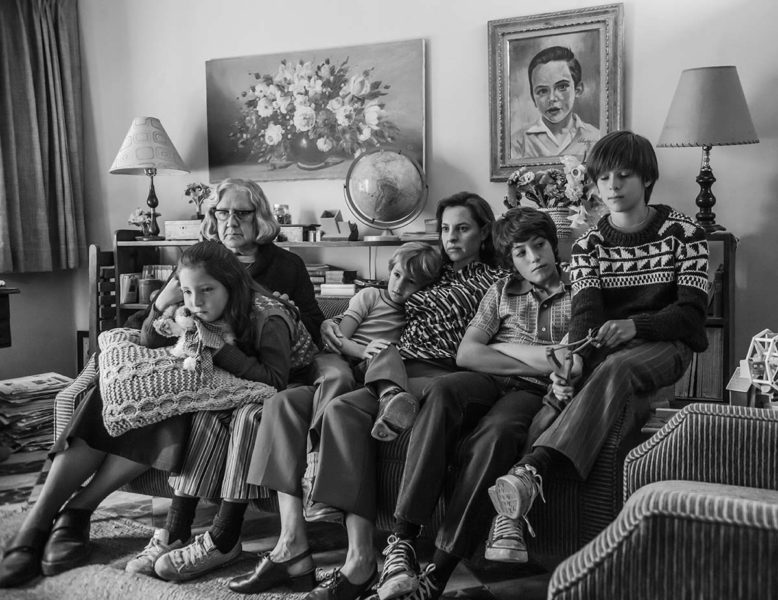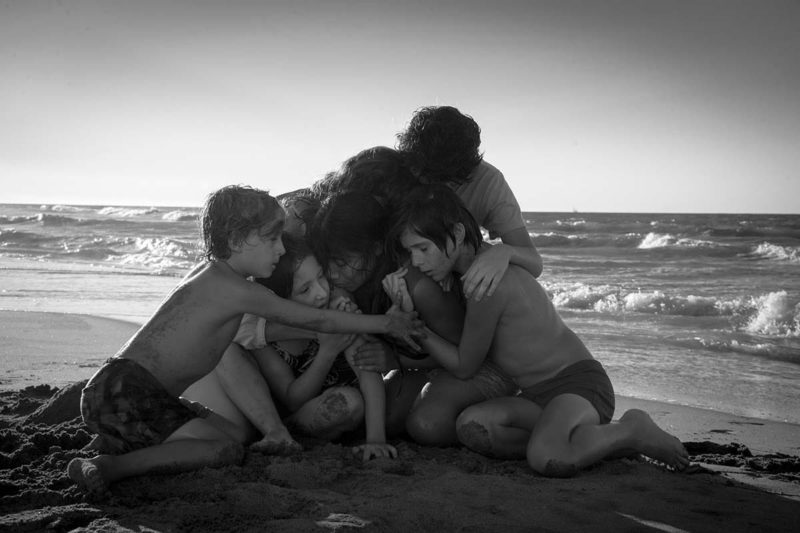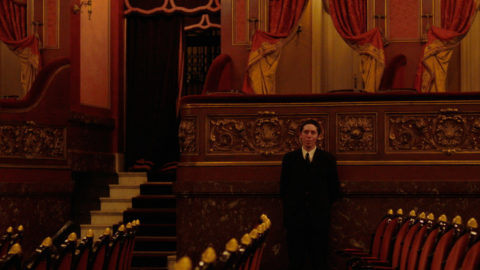Venice Film of the Week: ROMA
A passion project by a major director usually means one thing. Someone used to working with major resources gets to focus on a topic that’s intensely personal to them, trading budgetary compromise and a restricted canvas for the authenticity and intimacy they may be used to foregoing. None of the above applies to the new film by Alfonso Cuarón, who in any case couldn’t be accused of foregoing intimacy even in a spectacle like Gravity. But what’s remarkable about his new feature, ROMA, premiered this week in competition in Venice, is that it achieves a sense of closeness and of the intensely human while using resources that are, by conventional art cinema standards, imposingly expansive. ROMA catches both ends of a certain realist spectrum: a sense of historic sweep, as the film reconstructs social conditions in Mexico in the early ’70s, and an insight into the private domestic sphere.
Cuarón’s return to his native Mexico is also a belated sequel of sorts, or at least pendant, to the film that made his international reputation, Y tu mamá también (2001). That film explored contemporary Mexico through the bildungsroman of two pampered scions of the country’s bourgeoisie; the reality of Mexican working-class life was perhaps implicit as part of a travelogue backdrop, but was effectively absent from the heroes’ solipsistic experience. ROMA is a corrective to that film, offering a wider vision of Mexican middle-class life, and seen from an entirely different perspective—that a young housemaid working for a family in Mexico City’s Colonia Roma neighborhood in the early ’70s. The film is not only personal in subject matter, drawing on the filmmaker’s own childhood, but it’s his most hands-on film to date; where he’s previously worked successfully with DP Emmanuel Lubezki, this time Cuarón shoots the film himself, in resonantly metallic black and white.
The heroine is Cleo (Yalitza Aparicio), a young woman from the countryside who works for a family with four children, a resident grandmother, and a lively dog that spends much of its time leaping up and down in the house’s courtyard, when it’s not copiously shitting—the mess it leaves is at once a running joke and a poignant sign of the household’s mounting disorder. Father Arturo, a hospital doctor, is one of those patriarchs whose arrival is greeted with great ceremony: the children gather to watch him park his car, far too wide for the courtyard, cigarette in hand, classical music on the car radio. Arriving in style is his thing; after that, his presence barely registers. He leaves, supposedly, for a conference in Quebec. His wife Sofia (Marina de Tavira) eventually has to tell the kids why he’s been away so long; he’s spotted later in town, and heard of gallivanting carefree in Acapulco.

Cleo is deeply involved with the family, more than her co-worker Adela; she’s the one who puts the kids to sleep at night, and there’s a wonderful token of their intimacy when the family gather round to watch TV, and she and one of the kids share a cozy, casual embrace. The film is very much about the ambivalent status of household servants in Mexican society. Cleo is part of the family, loved but still absolutely an employee; when she and the family return from a holiday, she promptly goes downstairs to prepare refreshments for everyone. But the film traces the stages by which, through crises—her own and the family’s—their intimacy and mutual compassion is cemented even more powerfully.
The focus is on Cleo’s personal experience, however, and the parts of her life that aren’t accessible to the family. In particular, the film follows her ill-fated relationship with Fermín, a macho young guy whom she sleeps with—but only after he’s given her a spectacular display of his martial arts skills, using a shower rail as a samurai sword. She gets pregnant. A wonderful sequence at a cinema—where the film on screen is 1966 Louis de Funès comedy La Grande Vadrouille—shows her sitting alone, waiting for him to return to her side, although we know he’s fled on hearing the news. Partly because of the setting, this sequence recalls the vibrancy of Italian neorealism, in its evocation of a world in which live cinema was the backdrop to people’s everyday travails; there’s also a clip later from John Sturges’s space drama Marooned, which presumably meant a lot to the kid who would one day make Gravity. Cleo eventually goes to seek out Fermín at a martial arts training event where the star attraction is Professor Zovek, a real-life escape artist and willpower guru. Fermín turns up later in a troubling scene—the only one in which Cuarón indulges in wild coincidence—where he turns up armed with a gun as chaos breaks out, with his “Love Is” T-shirt (based on a cutesy cartoon strip of the time) taking on a bitter irony.
ROMA is set in a relatively enclosed world; for much of the time, it’s set within the family home, but it’s a world that Cuarón and production designer Eugenio Caballero map out in minute detail. By the end of the film, we feel we know every corner of the house, by all accounts a replica of Cuarón’s childhood home. When the family return one day to find their bookshelves have gone, the change in space is as much of a shock to us as to them. What’s especially striking is the way that ROMA locates the house in larger context, the Mexico City of 1970-71, and the political reality that governs it. The background is President Luís Echevarria Álvarez’s forcible quashing of student protest, partly through the use of a paramilitary group called Los Halcones, notably in the so-called Corpus Christi Massacre of June 1971. It’s arguably far harder to convincingly evoke recent decades than more distant history—if only because a lot of us remember exactly what hairstyles and T-shirts people wore in the 1970s, what cars they drove, what films they watched, and what political issues they worried about every day. What makes ROMA at once a meticulous and spectacular film is the amount of detail with which it reconstructs this particular milieu at this particular moment. Cuarón seems to have spared no budget and no attention when putting together his crowd scenes. I’m thinking especially of the buzzing of street life that surrounds a distressed Cleo as she sits outside the cinema, and a sequence where violence is seen explosively erupting outside the windows of a furniture store, as the children’s grandmother takes pregnant Cleo shopping for a cradle—a pointed juxtaposition of personal experience and public crisis.

This latter episode is followed by a sequence in which Cleo is taken to a crowded hospital to give birth—including a long meticulous single shot in which Cuarón’s attention to his characters’ emotions reaches a sort of critical mass of acuity, to heart-stopping effect. He uses long takes throughout, notably in a panorama of the laundry-draped rooftops of the Roma district, and in a climactic beach scene that is heart-stopping in a quite different way, and that must have taken extraordinary preparation and resilience from the actors, both adults and children. Alongside such show-stopping moments, which are absolutely earned, Cuarón only occasionally deploys poetic rhetoric. One such moment is a scene at a New Year celebration in the country, interrupted when a forest fire breaks out: locals are seen trying to extinguish it. The city children are encouraged to join in, but purely in play, putting out the smaller flames for fun, while the urban adults wander around, wineglasses in hand, enjoying the spectacle; one of their number, a man wearing the hairy costume of a local “Krampus” figure, takes off his mask to sing a song. It’s as if the middle class can’t be touched, by fire or by history. But the family are affected by crisis: one measure of it throughout the film is the damage done to the family cars, and their walls, as Sofia—sober or drunk—tries to park in the courtyard, while the dog shit continues to mount up.
In recent years, we’ve seen a number of films about the Latin American bourgeoisie and their relation to the working class and servants, but they have often been satiric (Sebastían Silva’s The Maid) or adopted an uncomfortable tone of the grotesque, as if to suggest that from a privileged bourgeois viewpoint, working-class existence could only be a matter of horror, sometimes embellished with a kind of mysticism (Carlos Reygadas’s extraordinary but hugely contentious Battle in Heaven). ROMA, though, attempts to tell a story from a servant’s point of view without either sentimentalizing or imposing an obvious social critique—and equally without hiding the economic differences that define people’s roles.
Cuarón achieves that by using a cast of nonprofessionals, with the notable exception of established actress Marina de Tavira, who brings a sometimes flamboyant set of emotional variations to Sofia’s troubled life. The nonprofessionals, including a bunch of children who are wonderfully energetic and at ease, are headed by lead Yalitza Aparicio, a young graduate in teaching studies from Oaxaca. Along with cast members including Nancy García, who plays fellow domestic Adela, she speaks much of her dialogue in the indigenous Mixteco language. It would be misrepresenting Aparicio to say that her Cleo is the calm, still center of the film—in several sequences, she projects emotional turbulence and challenged fortitude to devastating effect—but she often also embodies a contemplative inner strength that is the quietly vibrant through-note of this emotionally rich film. She’s certainly the magnetic center of a movie that has all the virtues of the tradition of humanist realism; and even if it’s made by a director used to mustering all the resources of the cinema of spectacle, he’s using them here to create a very intimate sort of immersiveness, one that’s all about steeping ourselves in the vividness of private emotion and public history.
Jonathan Romney is a contributing editor to Film Comment and writes its Film of the Week column. He is a member of the London Film Critics Circle.






